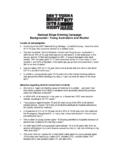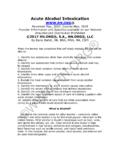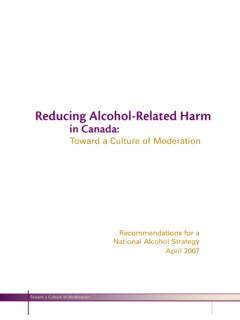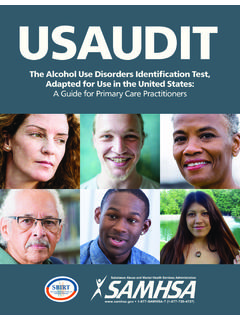Transcription of National Binge Drinking Campaign Backgrounder: The costs
1 National Binge Drinking Campaign backgrounder : The costs Alcohol-related harm is a major cause of mortality and morbidity in Australia, causing around 3,000 deaths and 65,000 hospitalisations every The annual cost to the Australian community in 2004-05 of alcohol-related social problems was estimated at $ The burden of alcohol abuse costs is split between three sections of the community: households, business and government. Business bore the greatest proportion of the burden with 50% of the costs of alcohol abuse, followed by the government sector with 26%.3 Workplace costs are a result of reduction in the size and capacity of the workforce and worker absenteeism due to alcohol-related Alcohol-attributable crime costs for 2004-05 were $4 billion while crime attributable jointly to alcohol and illicit drug use accounts for a further $ Of all violent crime offences for which prisoners were incarcerated, 15% were estimated to be causally attributed to alcohol, with another 7% attributable to both alcohol and illicit drugs.
2 After tobacco, alcohol is the second largest contributor to drug-related harm in Australia, causing harmful effects in the short and longer Short term (acute harm) relates to the risk of immediate harms from alcohol such as accidents, injuries and physical harms, often associated with Drinking to intoxication, whilst longer term (chronic harm) reflects the detrimental effects on the body of prolonged use of alcohol. Overall the main causes of alcohol-related deaths are cancer, alcoholic liver cirrhosis and road trauma, although the proportions of these vary by life stage. Younger people are more likely to die from bouts of intoxication, while older people are more likely to die from conditions related to long-term alcohol The World Health Organisation (WHO) ranks the harmful use of alcohol as the fifth leading risk factor for premature death and disability in the world and third among the leading risk factors in developed countries, after tobacco and blood WHO also notes that harmful Drinking among young people and women is an increasing concern across many countries.
3 1 Chikritzhs T, et al. (2003) Australian Alcohol Indicators: Patterns of Alcohol Use and Related Harms for Australian States and Territories 1990-2001, National Drug Research Institute and Turning Point Alcohol & Drug Centre, Melbourne. 2 Collins D., Lapsley H. (2008) The cost of tobacco, alcohol and illicit drug abuse to Australian society in 2004/05. Commonwealth of Australia. 3 Ibid. 4 National Alcohol Strategy 2006-2009 (2006). Towards Safer Drinking Cultures. Commonwealth of Australia. 5 Collins D., Lapsley H. 2008. 6 Chikrizhs, T., Jonas, H., Stockwell, T., Heale, P. and Dietze, P. (2001). Mortality and life years lost due to alcohol: a comparison of acute and chronic causes. Medical Journal of Australia, 174 (6), 281-284. 7 Chikritzhs, , Jonas, H., Heale, P.
4 , Dietze, P. Hanlin, K. & Stockwell, T. (1999). Alcohol-caused deaths and hospitalisations in Australia, 1990-1997. National Alcohol Indicators, Bulletin 1, December 1999. Perth: National Drug Research Institute. 8 World Health Organisation: Strategies to reduce the harmful use of alcohol [ ].








